Lomi Composter: Pros, Cons & Lessons Learned (After 1 Year+ of Use)
Did you know there’s such a thing as a “kitchen composter” appliance that turns your food scraps into dirt, so you can compost without a backyard?
Yep, I’ve been testing one of the most popular ones – the Lomi – for more than six months now.
So welcome to my review of the Lomi composter! This is what you’ll find here:
Note: This is part of my ongoing series of detailed, authentic reviews of products that claim to help us reduce our environmental footprints. Be sure to check out my other reviews here – you might find something you’ve had your eye on!
Who’s writing this review?
Hi, I’m Ketti. I have a master’s degree in sustainability, and have been testing products for years. I’m picky, and I don’t skim over the details. (But if you just want my quick pros and cons for the Lomi, click here. Or jump down to my final summary of this review.)
I’m excited to share what I’ve learned using my Lomi, and I must say – it’s been a long time coming!
After dozens of real uses (not “tests” under ideal circumstances), this isn’t another “I just opened the box, and it looks great!” kind of review.
Oh, no.
I’m not in the honeymoon phase. And I’m not just regurgitating specs from the side of the box.
I’ve been in the trenches with this kitchen compost machine for half a year now, through thick and thin. (Literally, thick and thin… I’ve composted everything from banana peels and watermelon rinds, to flimsy “compostable” packaging in my Lomi.)
And I’ve dealt with every smell and noise the Lomi produces – both the ones they tell you about, and the ones they don’t. So I’m here to give you my full, uncensored review of the Lomi composter.
But first, here’s a quick summary:
VIDEO Overview – How I Use the Lomi
What’s the difference between the Lomi and Lomi 2?
This review is based on the original Lomi Classic (later renamed Lomi 1 and, after minor updated, the Lomi 1.2). I purchased the Classic in January 2023 and, as of January 2024, it is no longer available directly through the Lomi website. (But you can still find it on Amazon. That link is the genuine Lomi made by Pela, not a knockoff!)
The company released the new Lomi Bloom in late 2023 (now called Lomi 2) – and the update does fix both of my complaints about the original Lomi. Still though, when they first launched the Bloom, I thought that for a $100 price increase… not much had changed.
But now (as of March, 2024) they’ve brought that pricing down to where the Lomi has always been, around $500 when there’s no seasonal sale.
NOTE: I’ve started using the new Lomi 2 (as of August, 2024) and will write an updated review once I’ve had a chance to thoroughly test it. Stay tuned if you’re interested!
What’s New?
The most functional update is that Lomi says the new Bloom can run a cycle “up to two hours faster.” It also has a cleaning cycle. (Although I’ve never had a problem cleaning my original Lomi – I just put the bucket in the dishwasher every month or so.)
The Lomi 2 also comes in three colors, instead of just white, and it has a clear “skylight” lid, which I do think sounds cool. (You can watch your compost happening! Great idea if you have kids in the house, too.)
Beyond that, the Bloom connects with an app that measures how many carbon emissions you’re saving with each cycle. (Which is, as I describe below, the real environmental benefit of the Lomi – whether you measure it on an app or not.)

So whether you go for the Bloom (AKA Lomi 2) or the original Lomi, I’ll tell you right from the start: It’s not perfect, and it’s not for everyone. But are some important benefits that I’ve been impressed by, so let’s start there:
Biggest (Environmental) Benefit of the Lomi
After six months of experimenting with my Lomi, I’d say the most noticeable benefit is that I now take out the trash, at most, half as often as I used to. And it no longer stinks or leaks at all.
I know – fewer garbage runs is kind of a boring “pro” for a pricey tool. (To be clear, it’s essentially a $500 dirt maker – although they do offer some discounts throughout the year.)
[Here’s a less pricey home eco-improvement that I recommend to everyone.]
But really, that’s the whole point of compost, at least in terms of sustainability: Sending less stuff to the landfill. By making it into dirt, instead.
And using the Lomi has easily cut our landfill contributions in half!
As a household of two, with lots of home cooking and lots of vegetables, pre-Lomi, we had a smelly, over-stuffed garbage bin every week for trash day. Now, we only take out our garbage every two weeks at most, and it never has even a whiff of bad smell.
[Related: Speaking of cutting down on chores, the grocery delivery service I reviewed recently has has cut my grocery shopping days in half, just like Lomi cut my garbage hauling days in half!]
So what? Here’s why that matters:
Food makes up 21% of what goes into landfills in the US. (I found that stat shocking.) It’s the largest single source of waste in the US.
When food breaks down in a landfill, it breaks down into methane – a greenhouse gas.
The EPA says methane is at least 28x more powerful than CO2 at trapping heat and making climate change happen. (This happens because a landfill is an anaerobic environment – no oxygen, which is necessary for composting. That’s why the Lomi is ventilated, keeping air running through the composter while it breaks down food scraps.)
Before:

After:

So that’s the main environmental benefit to using a Lomi composter – less methane heating up our atmosphere.
[Related: Here’s what I’m doing about the GHGs that are already in our atmosphere.]
Sure, it’s great to put the Lomi compost to use as a gardening input, too, instead of wasting all that nutrition in the landfill. (Even just scattering it around on grass somewhere, as I often do.) But really, the most significant of Lomi benefit is to the climate.
Plus, there’s the added bonus of making our kitchens smell better – no more smelly trash.
Here are the other main pros (and cons) of the Lomi, from my experience using it:
Quick Pros & Cons of the Lomi

Lomi kitchen composter – Quick Pros & Cons
- Very easy to use
- Creates nutrients for your garden
- Dishwasher safe compost bucket
- Diverts food from landfills, reducing climate impact!
- Works with food (including meat & cheese), bioplastics & packaging
- Fast – food scraps to dirt in a few hours
- It cut my garbage in HALF (literally)
- ... which saves time and $$
- Smells yeasty when running. (Pro or con? You decide)
- Requires electricity (a net "con" only if your power source is coal!)
- $$ to get started (similar to alternatives)
- Doesn't break down bioplastics as quickly as I'd hoped
Lomi 101: What is it?
The Lomi is made by the Canadian company Pela – yes, the same Pela that makes compostable phone cases out of a flax-based bioplastic. (That’s a plant-based oil, instead of petroleum-based, which gives them a nice, soft texture.)
I’ve been using one of their cases for years now and like it a lot. Plus, theoretically, you can actually compost your old Pela case in your Lomi. (But… I’m skeptical. More on that below.)
Pela is also a certified B Corp, Climate Neutral certified, and a member of 1% For The Planet. All around, these are reliable signs of a good, responsible company.
How does the Lomi composter work?
The Lomi uses heat, ventilation, and bacteria to break down food scraps, while a wand rotates to stir the pot and crush up larger pieces. It sounds kind of like a slow-moving mixer crossed with a bread machine. But the combination of heat, aeration and mixing make it more like a compost bin on steroids.
After about 6 hours, forgotten leftovers, apple cores, and veggie trimmings are converted into something similar to compost.
Using it is straightforward: The Lomi has one button. Push to turn it on. Hold it down to switch between the three modes. Push again to start. That’s all. (This is the same for the Lomi Classic and new Lomi 2 / Bloom.)
Unboxing: Mostly Plastic-free Packaging
fMy first impression when I opened the box: Lomi walks the walk, in terms of their plastic-free packaging – mostly.
The composter arrives in a big cardboard box. The only trace of plastic is the outer packing tape. (I asked them about this, in case it was actually plant-based tape that could be composted with the Lomi. The answer was no.)
Other than that, the interior padding is made of recycled cardboard, and there are no plastic-y marketing inserts (hallelujah). Just two paper flyers with instructions. The device is also wrapped in a bioplastic bag – Lomi-approved, of course, so you can compost it with your first cycle.
That’s just what I did – an early test of how well Lomi would handle compostable bioplastics. (See below for how it went.)

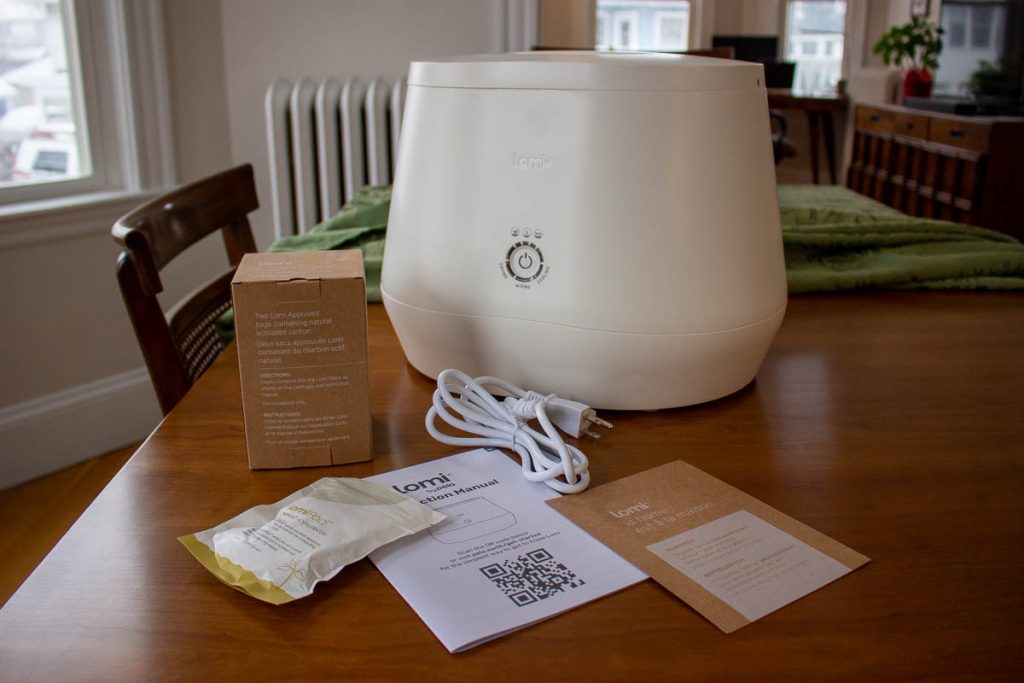
Setting Up Our Lomi:
First, I added the special charcoal pellets to our Lomi when I took it out of the box – these are the filter that reduces the smell running a cycle. It was very easy to do, and lasts dozens of cycles.
(Lomi says to just replace the filter pellets when you start to notice a smell, or roughly every 45 uses. And you can compost the old pellets in the Lomi! After six months of use, I still haven’t noticed a change in the smells, so I haven’t replaced mine.)
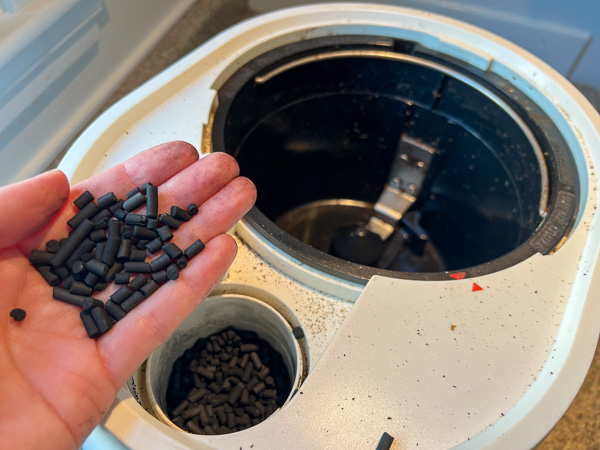
These are the Lomi’s three modes and my experience with them:
- Eco Express Mode – the default. In my experience, this cycle usually takes about 6 hours. (Lomi claims as little as 3 to 5 hours, but so far, I haven’t seen it finish that quickly.)
- Lomi Approved mode – designed for composting bioplastics, this mode uses a higher temperature, but still takes about 6 hours – or a little longer, if there are more bioplastics in the mix.
- Grow mode – the slowest and lowest heat mode. The biggest difference versus the other cycles is that Grow mode takes as long as 18 hours. The lower heat is designed to keep more microorganisms alive, so the output is more beneficial for your garden. Lomi says to only use raw fruits and vegetables in this cycle – no bioplastics, and no cooked foods. (But I’ve often ignored the cooked foods ban and haven’t noticed a problem.)
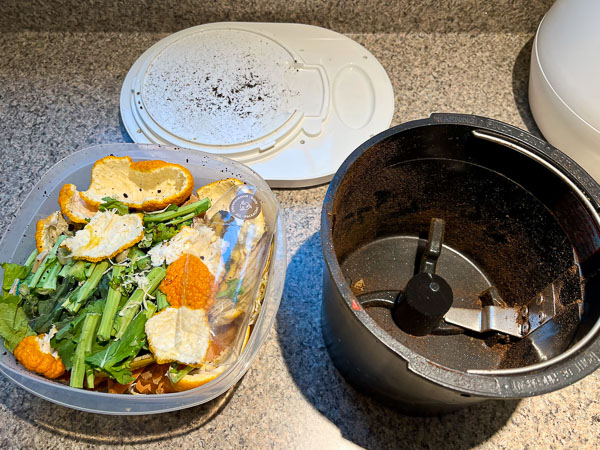
What comes out of any of the modes isn’t exactly compost – at least not in gardening terms. It’s more accurate to call it a pre-compost. And Lomi is very clear about this – the output has to be mixed with regular dirt to use it for gardening, at a ratio of 10 to 1. (That’s 10 parts normal dirt, 1 part Lomi output.)
Of course, I tried breaking the rules with this, and the results weren’t great. (More on that below, in my “lessons learned” section.)
Does Lomi really break down bioplastics?
For food waste, the Lomi the does quite a respectable job (more about that below). But with bioplastics and other packaging labeled “home compostable,” my results have been a bit different.
Tip: There’s a difference between “biodegradable” vs “compostable.” Technically, anything will biodegrade if you give it enough time. “Home compostable” products can actually break down under the conditions of a normal compost pile or, likely, in your Lomi. Without the word “home,” a product might only be “industrially compostable,” which could mean it requires more heat and other special conditions.
For my first tests with the Lomi, I threw the bioplastic bag that the Lomi came wrapped in into our first cycle. (Using the Lomi Approved mode, which is designed for bioplastics.)
Here’s how it came out:
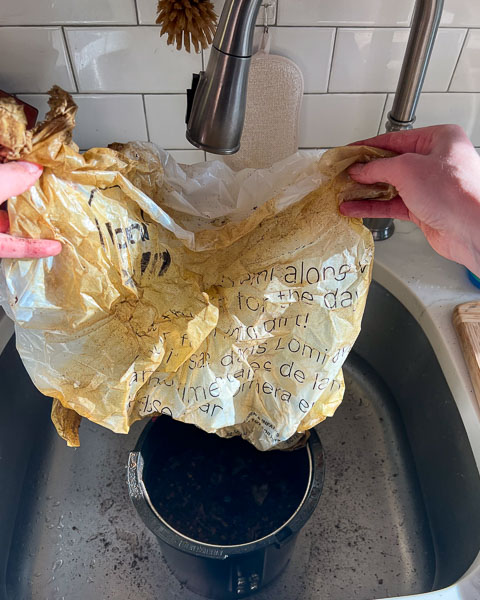
I was worried this was going to have to be a very negative review after I saw that. So I got in touch with Lomi to ask them “what gives?” I mean, if any packaging should be “Lomi approved,” it should be this, right?
They said the result was normal, and it often takes multiple composting cycles to fully break down packaging.
They also recommended cutting up packaging into smaller chunks before trying to compost it.
So I did that, snipping the Lomi bag into chunks about 3-inches square, and I added the pieces to the next cycle. It came out like this:

Clearly the compostable bioplastics are breaking down, just not quite as easily and thoroughly as I’d expected. And I’ve tested it with lots of other packaging since that first run. (I have a pretty good supply on hand from other products I’ve reviewed.)
Here’s the packaging I’ve composted in my Lomi:
- Dew Mighty skincare: These refills come in paperboard packaging with a plant-based coating. And I can’t find any sign of it after just one cycle in the Lomi.
- SBTRCT skincare: Similar to Dew Mighty, but British, with plant-based film wrappers on their skincare bars. Lomi ate them up. (Read my SBTRCT review here.)
- Hold On compostable garbage bags: I’ve gotten in the habit of using one of these to collect food scraps for every Lomi cycle, which makes for an easier transfer – just put the whole bag in the Lomi. It breaks down better than I expected, and definitely better than the bag the Lomi comes in. (Photos below.)
- Terraseed vitamins packaging: These come 100% plastic-free packaging (a very unique cardboard tube!). While they say the tube is home-compostable, it’s pretty solid, so I always just recycle it. But I compost the bioplastic film that the tube comes wrapped in, and it always completely disappears after one Lomi cycle.
- Bite Toothpaste Bits and Blueland product refills: Both come in very thin, home-compostable paper packets. And both require at least two cycles to really seem broken down, but then they come out just fine – as long as I cut them up like this:

Tip: It really does make a difference to cut up any bioplastics into smaller pieces before composting them. Beyond that, it’s been surprisingly hard to predict what will work well and not so well. Either way, it’s just a matter of time and how many Lomi cycles it will take to break down different materials.
That was probably the most negative part of this review. All of my food test in the Lomi have worked surprisingly well.
Can you really compost Pela phone cases in the Lomi?
Okay, so, as I said above, the Lomi composter is made by Pela – the company that’s famous for its plant-based phone cases. And Lomi says the Pela phone cases are “Lomi approved,” meaning that in theory they can be composted and broken down by the Lomi-approved cycle.
But obviously, the cases are a much thicker, heavier material than the thin bioplastic packaging I’ve been experimenting with. If it takes two or even three cycles to mostly make those disappear, how many would it take to make a phone case break down?
I don’t normally turn down a good test, but I just really can’t see how this could work.
And to be totally honest, I’m not sure it’s worth sacrificing my perfectly good, pretty purple Pela case for the test, especially when I just don’t think it’s the most important thing about the Lomi.

Besides, what Lomi is really for – and where it really makes a difference for the environment – is food waste.
That’s my excuse. Let me know if it flies with you…
I’ll be traveling for the next month, but if you want to see me test composting a Pela case in my Lomi, let me know in the comments and I’ll make it happen!
Food Diaries: What can you actually put in the Lomi?
In general, almost anything edible is Lomi compostable. (Here’s the full list of which foods you can and can’t put in a Lomi.)
And over the past six months, we’ve been purposefully testing the limits of what Lomi can handle with some questionable items.
“Can you put banana peels in the Lomi?”
For some reason, banana peels are the item that people are always most incredulous of when they see my Lomi on the kitchen counter and start asking questions.
But surprisingly, Lomi handles most tough, fibrous foods, like banana peels, avocado skins and even watermelon rinds basically flawlessly. I haven’t been able to find any identifiable bits of any of them left over after any of the cycles. (And I usually dig through the Lomi dirt and look.)
Artichokes tend to be more identifiable, but definitely still get broken down enough to avoid attracting animals in a garden bed.
Eggshells also disappear better than I expected. (Actually, the Lomi handles eggshells better than our backyard compost pile ever did when I was a kid, which is impressive. Crushing them up just a bit before putting them in the Lomi does help a lot.)
Tea bags also disappear perfectly, as far as I can tell. Lomi says that you should only compost loose leaf tea, but I’ve been putting in tea bags. (Just make sure they’re plastic-free tea bags – which is definitely not a given – and remove any strings or staples.)
I learned quickly that including much of any dry foods – like the time I Lomi-ed a pound of stale flour – will make the output very dry and not very useful for gardening.
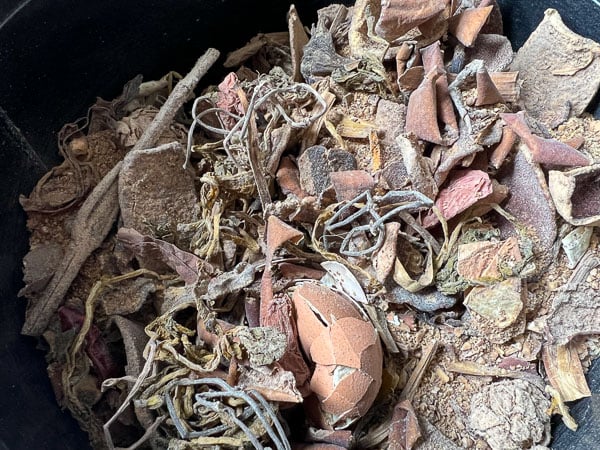
However, if you just add a couple ounces of water (which you should do when using a LomiPod, anyway) it comes out much better.


Who should actually have a Lomi?
It’s really not for everyone, but if at least one or two of these apply to you, you might be a future kitchen composter.
Travelers. You’re away a lot, and don’t want to deal with constantly pausing and unpausing a compost pick-up service.
Gardeners. Whether it’s a community garden, potted plants on your balcony, or backyard flower beds, if you do any gardening at all, you’ll have a use for the Lomi dirt. (And a responsible way to get rid of it, instead of putting it the landfill.)
People who don’t want to bother with compost. Maybe you do have a backyard, but just aren’t into the idea of rotating a smelly, heavy compost pile? Or dealing with another service? No shame! That’s why we have multiple solutions to this food waste problem, and Lomi is one of them.
…or composters in cold climates. The Lomi is a great alternative to outdoor composting for the winter months, when compost piles just don’t work. (You can save up the Lomi dirt and throw it in your compost in the spring as a “brown.”)
Renewable energy users. If your house/apartment is powered by renewable energy anyway, using electricity to compost isn’t a big deal. It’ll be a net benefit in terms of climate emissions. (And you can easily switch to renewable energy in most states!)
Tech lovers and/or kids. Hey, the Lomi is a pretty cool gadget, and it’s the result of lots of custom engineering and design. There’s no shame in getting some fun out of a futuristic way of reducing your climate impact!
People with the budget. At the end of the day, we’re talking about a $500 tool. If that’s a stretch for your budget, there are plenty of cheaper ways to improve your climate impact. (Like switching to renewable energy, buying less new stuff, driving and flying less… I could go on forever!)
Who shouldn’t buy a Lomi:
If you live in a place where your electricity has to come from a carbon-intensive source (like coal), and you plan to put your Lomi dirt in your garbage and send it back to the landfill, then it’s better to just skip it.
Remember, the main sustainability benefit of the Lomi is keeping food scraps out of landfills, where they’ll break down and create methane. But using dirty electricity to partially break down food scraps, and then sending them to the landfill anyway wouldn’t have any net environmental benefit. (Probably the opposite, in terms in energy use and climate impact.)


My Best Lomi Tips After 6 Months of Trial & Error
Definitely read this part if you’re thinking of buying a Lomi! These are my insider tips, hard won after flouting many Lomi “rules” – and learning which ones actually matter.
You can put in more than they say.
I usually fill my Lomi way past the fill line. The bucket should technically only be 75% full, but I tend to go all the way to the top – to the point where I have to squish the lid on (as Lomi explicitly says not to do). So while this is definitely not an officially approved tip, I haven’t had any problems with this method.
However, I decided to do a purist, 100% rule-follower test, to see if it would make the Eco-Express mode as fast as Lomi says it should be. (3 to 5 hours.)
I filled the bucket right below the fill-line, skipped the compostable bag I normally use (see below), and added a LomiPod with a bit of water. I’m surprised to say that even then, the composting time was the same: About 6 hours.

No garden? Find a green spot to dump your Lomi dirt.
I have house plants, but I’m not enough of a gardener to use everything that comes out of our Lomi.
So I usually end up storing a few weeks’ worth of Lomi dirt in a Tupperware and then finding somewhere to dump it. My go-to dump sites: Scattered on the lawn of my backyard, or in the dirt of the trees by the sidewalk outside my apartment.
(The Lomi dirt is really light, and Lomi reduces the volume of scraps impressively, so it’s really easy to cart a few weeks’ worth of output to the nearest tree.)
When there’s snow on the ground, I store it up and wait for spring.
You could also offer your Lomi dirt to gardening neighbors. After all, it’s fertilizer – which people pay for!
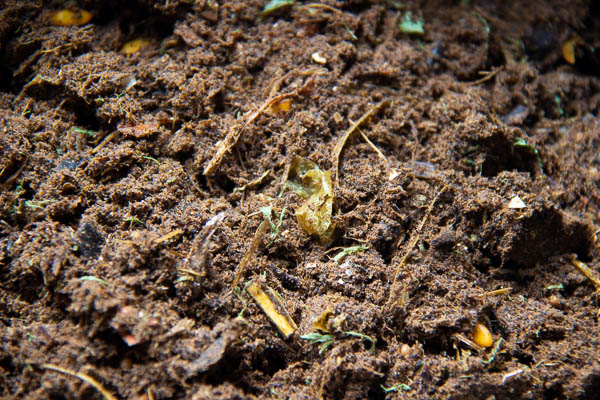
Collect scraps in a compostable bag in the fridge. (Less mess + smell!)
The Lomi itself is airtight, so it doesn’t smell if you collect your food scraps right inside it – except when you open it. And if you have a small household, or you were out of town for a few days and didn’t run your Lomi, or it’s summertime, it will be stinky when you open the Lomi up to add more scraps.
So one thing that I’ve found makes the Lomi significantly easier to use is storing food scraps in a small, compostable garbage bag, which I can then include in the Lomi when I run a cycle.
I use the small, 4-gallon compostable bags from Hold On. (I have a discount code for them if you want to try them.)
Use the code TILTEDMAP for 15% off any order from Hold On.
They’re not officially Lomi-approved, but they work well enough. (These bags from Repurpose are a similar option that is Lomi-approved. No discount though.)

(We’ve been testing Hold On’s large garbage bags, too. While they’re definitely not as strong as normal plastic garbage bags, it hasn’t been an issue since we started using the Lomi – now that our garbage is light weight, dry, and non-stinky.)
Anyway, I digress. Let’s get back on track:
Here’s how I use compostable bags with the Lomi:
I put a Hold On bag inside a 14-cup (3.3 liter) Tupperware, which I keep in the fridge while I’m filling it up for the few days between cycles. The size is just slightly more than Lomi’s capacity. (A little more than officially allowed, but we’ve already established that I’ve broken that rule without a problem.)
Then I just lift the bag and put the whole thing into the Lomi. This is much easier than pouring a pile of scraps into the hatch, which almost always causes a bit of a mess.
And despite including the compostable bag, I still don’t usually run the Lomi Approved (bioplastics) cycle. But the results are about the same with the standard mode.
The bag doesn’t break down fully in one cycle, but it hasn’t caused problems.


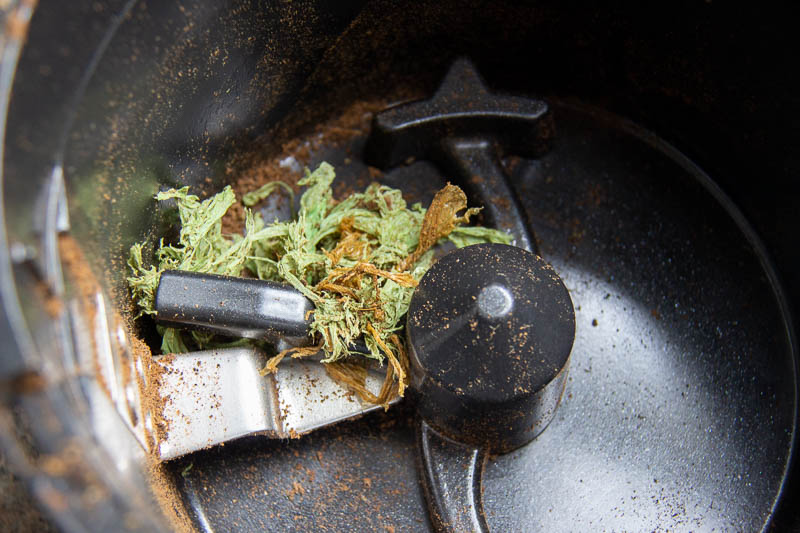
Sometimes I’ll leave the chunks of the bioplastic bag in the dirt and run it all a second time, adding a smaller load of scraps on top. Sometimes I’ll just pull the bag remnants out and throw them in the garbage.
Either way, it simplified the process and minimizes mess.
Don’t worry about the LomiPods.
Do you need to use LomiPods? In short, no. These tablets (the white dot, in the middle photo up above) are completely optional.
The main ingredient in LomiPods is the company’s own blend of probiotics. Lomi says their purpose is to “speed up the breakdown of kitchen scraps and other Lomi-approved products, giving you the best end product for your plants.”
After dozens of tests, with and without the LomiPods, I couldn’t find any noticeable difference in the output, the smell, or the time needed to run a cycle.
If you’re just using one of the fast cycles, and plan to toss the dirt in the park, then the pods don’t significantly change or speed up the process.
However, the LomiPods might be useful when you’re using the Grow cycle, and want to make sure you’re making good, nutrient-rich soil for your plants. (But I’m not enough of a gardener to put that to a fair test.)
No, you can’t use 100% Lomi dirt in place of potting soil.
They were clear about this, but I didn’t listen.
Despite Lomi’s unambiguous warning, as I described above, I wanted to test using 100% pure, unblended Lomi dirt in my potted plants. And I can confirm the company isn’t just being overly cautious – it actually does not work.
The result was a stinky pot after about two days (as the Lomi’s pre-compost dirt continued to break down), followed by a layer of fluffy mold, and a dead plant after about two weeks.
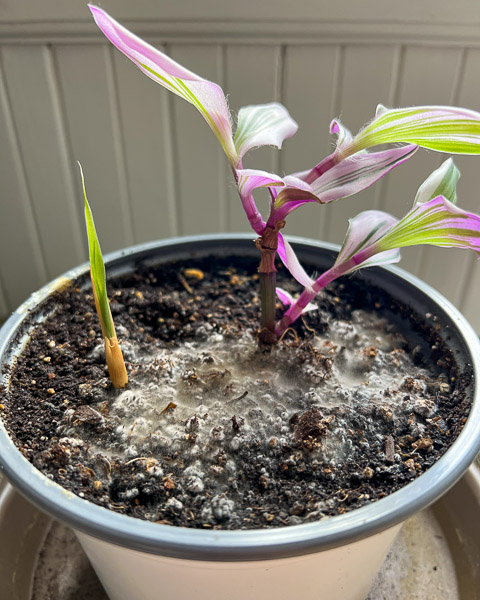
If I’d mixed Lomi dirt with regular dirt, as instructed, none of this would have happened, but I just had to see for myself.

The truth about Lomi smells
There’s no denying it – even though I’ve seen lots of Lomi reviews online that do: The Lomi does give off a smell while it’s running. There’s just no denying that.
It’s not nothing, but I don’t find it offensive. It’s a yeasty smell that reminds me of a brewery or a sourdough starter. And to me, that’s really not a bad thing! I actually usually find it pleasant, but that’s for you to decide.
My husband is less convinced – but to be fair, I suspect he’s actually part bloodhound. (He can smell when I’ve eaten garlic the day before, so the fact that he notices it but doesn’t hate it means it can’t be that bad.)
And the odor really depends on what you put in your Lomi. That’s what I’ve found for the odor while the Lomi is running, and even more so for the smell of the resulting Lomi dirt.
For example:
Does Grow Mode smell worse?
The first time we ran the Grow mode cycle, the smell of the resulting compost was absolutely horrendous… But then we remembered we’d put the rind of a very strong French cheese in there. So we ran it again — re-composting the same French dirt, plus enough new food scraps to fill the bucket.
After running the Grow cycle again, sans fromage, the smell was actually pretty mild and unoffensive. So the theory that Lomi’s grow cycle smells more than the others was pretty much toasted.
The truth about Lomi’s noises
Normally, I’d say the Lomi is a bit louder than a refrigerator, but quieter than a dishwasher. (Okay, if you have a very new, super silent dishwasher, it’s louder than that, but it’s definitely not obnoxious.)
I usually run it at night in our small apartment. With the door to the kitchen closed, we don’t hear a thing.
What about weird Lomi noises?
There are some exceptions to the rule above, though. Sometimes Lomi makes a low, grumbling sound – like there’s an angry cat, or maybe a happy whale, slowly making its way through our kitchen.
The folks at Lomi haven’t been able to give me an answer for that specific noise. But in general, they say some grinding or squeaking noises are normal, as long as they aren’t too loud. They’re often caused by things like coffee grounds squeaking under the mixing wand.
But if the noises are really loud, something could be stuck in the machine’s grinder, and you should fix it. Luckily, I’ve found that to be even easier the official directions say.
Official instructions for what to do when Lomi makes weird noises:
Turn off the cycle, by holding down the button for 10 seconds. Open the top and let it cool for 30 minutes. If your batch is heavy on compostable bioplastic or packaging, they recommend adding more organic waste, if you have it, to smooth things out.
What I do when Lomi makes weird noises:
(These are the off-label instructions that I’ve found work just fine.)
- Turn off the cycle by pulling the plug out of the wall.
- Open the hatch.
- Use a wooden spoon to stir the pot and remove any obstruction.
- No need for a 30-minute pause. (I’ve never found the contents of the Lomi that hot.)
I only do this when it really sounds like it’s working hard and might be jammed up.

How much does it cost ($ and Energy) to run a Lomi cycle?
The initial price tag might be a shock when you’re looking into the Lomi – the machine itself is $500, before any discounts. Then there are the maintenance expenses: The cost of electricity to run the appliance, charcoal filters to replace, and (optional) probiotic “LomiPod” tablets to add to each cycle.
By my calculations, using the Lomi costs about $1 or less per composting cycle. (Technically, between 64¢ and $1.50 per Lomi cycle.)
[Related: Want a sustainable swap that only costs a buck or so total? Try this! (Well, a dollar or so each roll, I mean.]
If you feel like diving into the arithmetic, here’s how I came up with that price range:
First, electricity. Lomi uses about 1kWh (kilowatt hour) of electricity for the longer “Grow” cycle (the one that produces plant-friendly soil that you can mix into your garden). That’s less energy than running a dishwasher for one cycle.
And the “Eco-Express” and “Lomi-Approved” modes use about half that (.5 kWh per cycle).
Since the average price for electricity in the US is 16¢ per kWh, that means the electricity costs roughly 8¢ to 16¢ per Lomi cycle.
Renewable Energy Tip: I chose an electricity provider that uses 100% renewable energy, and it costs slightly less than average in the Boston area. In most cities, you’ll have multiple options for energy providers and can choose one that uses renewables!
The Lomi charcoal filters should be changed after 45 Lomi cycles. At the rate I’m using it – about twice a week for a two-person household – that means I’ll change the filters every six months or so at the most. I’m right at six months now, and haven’t noticed a need.
(The filters aren’t technically required to run the Lomi, but they help absorb gasses from the natural decomposition process, and thus reduce smells.)
The best deal is 4 replacement filters for $100. Since the filters should be replaced every 45 cycles, that makes them 56¢ per Lomi cycle. If you have a full household and use your Lomi daily, it would definitely make sense. If you buy just one replacement filter, it’s $30, or 67¢ per Lomi cycle
Finally, the optional LomiPods cost 36¢ to 67¢ per pod, depending on how many you order.
So the cheapest route, if you are reading this minutiae and want to check my math:
+ no LomiPod (0¢)
+ buying Lomi filters in bulk (56¢ per use)
+ running one of the shorter Lomi cycles (8¢ of electricity)
= 64¢ per use
Or if you want to use LomiPods, but don’t want stock up too much on them, or on filters, and you use the longest, most energy-intensive Grow cycle:
+ LomiPod not in bulk (67¢)
+ Lomi filters not in bulk (67¢ per use)
+ running one of the longest Lomi cycle (16¢ of electricity)
= $1.50 per use
(You can also save 10% by subscribing for deliveries of any of these Lomi refill items.)
If you pay for your garbage collection service, you can save hundreds of dollars per year by reducing the size of your dumpster, or the frequency of pick-up.
Again, in my house, we’re taking out the garbage half as often now vs. before we started using our Lomi.
And it’s reducing our contribution to the single largest source of waste in the United States, and reducing the climate impact of landfills. I’d say those things are worth $1 per use.

What I’d like to see improved on the Lomi:
None of these are major issues, or affect the functionality. They’re just what I would change:
- I wish the Lomi had a status indicator of some kind, so we could tell how soon it would be finished. (It does have an indicator that shows the three main compost phases – Mixing, Drying, Cooling – but that’s pretty vague, as each phase lasts a couple of hours.)
- I wish the clear lid were included! Earlier this year, Lomi offered see-through lid as an upgrade. It might just be the nerdy product tester in me – but how cool does that sound?!? Right? You’d get to SEE the compost process happening, and how broken down your scraps are at every phase. (And I could make a fun time-lapse video of it! I’ll do just that and add it here if it’s ever available again.)
UPDATE: Lomi has actually made both of these improvements I was hoping for with the new Lomi 2. (I like to think this review played some small part in that. 😉) Is it worth an upgrade, if you already have the Lomi Classic? Personally, I don’t think so, unless you have someone to gift your original Lomi to.
Lomi Alternatives
Lomi isn’t the only countertop composter out there, but there are several reasons I wanted to try it before the others.
First, the Lomi seems simpler to use, and much faster.
Most other composters require mixing special additives into your food scraps, or keeping track of precise amounts of scraps. They also take longer (some take up to days to produce the output), and are more finicky about what you can put in. (Some don’t work with any animal products, or with bioplastics.)
Second, the Lomi just looks better.
This might be a minor factor, but when you consider that you’ll probably have this appliance on your kitchen counter for years to come, it’s amazing that Lomi’s competitors didn’t even try to make their products easy on the eyes. (In my opinion, at least. Take a look below and you’ll see what I mean. Most of them look industrial, and not in a chic way.)
The price tags on the Lomi alternatives are about the same. I’m thinking of the beyondGREEN Kitchen Composter ($430), the the Reencle Home Composter ($500), and the Vitamix FoodCycler FC-50 composter ($400). (Photos from left to right.)
Lomi also has a more generous trial period than the others. (30 days to try it, and you can return it if you don’t like it.)
Lomi vs. Local Compost Collection
Without a doubt, though, the best alternative to Lomi is a local compost collection service.
More and more cities are offering this alongside normal garbage and recycling collection, so definitely check with your city before you invest in a Lomi! (I’ve been on a waitlist here in Boston for months.)
What the compost is used for varies by location. Either cities contribute the soil produced to community gardens, or use it to create biogas as an energy source – although the climate benefit of biogas is questionable.
Local compost collection companies are another great option! (The fact that they use the food scraps for actual compost means the climate benefit is guaranteed.) But they’re also not always cheap, and not available everywhere. In the Boston area, I’ve found options ranging from $15 to $44 a month.
So, considering that a composting service could easily cost at least $300 a year, the Lomi would pay for itself in less than two years.
And if you travel anywhere close to as much as I do, the Lomi makes more sense than paying for a service I’m not using. I just push the button when I need it and leave it unplugged when I don’t.

My Final Thoughts on the Lomi:
After six months of real-world testing my Lomi, I’m happy to say I would definitely choose it again. The innovative small company behind it is worth supporting. The quality of the manufacturing is clearly solid, and it does what it promises!
I haven’t had any problems with it at all. Plus, the Lomi seems more versatile than the other countertop composters I’ve found.
So if you have the budget for it, and want to reduce your food waste – and thus your climate impact – without dealing with outdoor compost or committing to a service, I still think the Lomi is a great choice.
But if you do have space and desire for outdoor composting, then you could accomplish what Lomi does without electricity. Fantastic! (Although, the Lomi would still be a useful tool for your winter composting.)
Similarly, if you live in a place with a municipal composting service available – and don’t care about keeping the Lomi dirt for your garden – try signing up for that first!
And if your power source is really carbon heavy (eg: coal power plants) and you don’t have a use for the Lomi dirt, then it’s not going to be a net benefit for the environment.
But for everyone else, both the original Lomi and the updated Lomi 2 are fantastic tools for reducing our climate impact, and for that reason, either one would make a worthy investment in the future.
I hope you found this review of the Lomi composter helpful! Questions? Let me know below in the comments and I’ll do my best to help.
Before you go:
I mentioned above that I’ve composted the packaging for my Bite Toothpaste Bits – a plastic-free product I’ve been using for years. If you haven’t tried them yet, check out my Bite review here!
More popular reviews of sustainable products:
- Misfits Market review – perfectly good groceries that would have been thrown away, delivered to your door!
- Bamboo VS Recycled Toilet Paper (which is greener, and which is softer?)
- Where I put my donation budget for carbon removal
- my most recent shampoo bar review (of Viori brand, which comes in paper packaging too beautiful to compost)
- my comparison of some of the best plastic-free razors
- and my favorite travel clothing (which is technically compostable, too!)




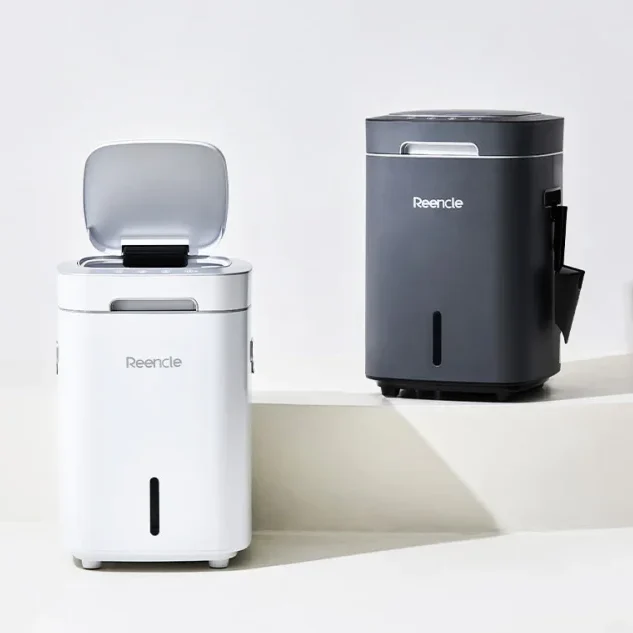







I was about to buy a Lomi but then did a bunch of reading and ended up with Reencle. It’s only been a couple weeks, but I love it. Would be curious to hear what you think. It did come packed in styrofoam (booo) and I haven’t tried any bio plastics yet. But I like that you don’t need to subscribe to filters/Lomi pods. It also runs continuously which I think is more convenient than having to save waste up to run a cycle. (Even so, they claim it uses less energy than Lomi). And, they say its “product” is “real compost”, unlike lomi’s.
Hi Alex!
That’s great, I’m glad you found something that’s working for you! As you may have seen already, Reencle is one of the Lomi alternatives I mentioned above, and it’s the one I’m most interested in trying. (Definitely disappointing about the styrofoam, though. I was happy that Lomi did the opposite, with all cardboard packaging. In fact I should add a photo in the review above – thanks for reminding me!)
Anyway, it seems like a great concept, although I actually have really liked the way the Lomi works with saving up scraps to run. My husband I run it about twice a week, but it’s nice because we both travel a lot, so when we’re gone for a couple of weeks we just unplug it and don’t have to worry about what point in the cycle it’s at. (One of my “concerns” for why the Reencle might not work for our lifestyle.)
And you’re right that the “Lomi dirt,” as they call it, is a pre-compost, not fully finished compost. I’d be interested to see the difference in the output between the two machines first hand. But since we mostly spread our Lomi dirt in the back yard (our motivation is climate impact more than gardening) it’s not a big factor for us.
I’d LOVE to hear how the Reencle handles bioplastics! If you ever try any, by all means, let me know!
Thanks again for sharing your thoughts!
Ketti
Fwiw, Reencle did comment somewhere that they’re switching away from styrofoam packaging! And good point about traveling. They say if it’s less than a week you don’t have to do anything, but longer than that I think you have to not add anything for two days, then unplug it while you’re gone. And I am also not a huge gardener, so the quality of the compost isn’t super critical- but I am going to plant some tomatoes in the backyard and will try it! Haven’t tried any bioplastics yet (bc I haven’t had any) but I did handle a blueland wrapper just fine!
Awesome! That’s great, by all means, keep me posted on how it’s going with Reencle! But yeah, the other half of my job is writing about sustainable travel (I’m currently in Europe for three weeks 🙂 ) so the travel flexibility is definitely key for me!
Hello Ketti, I’ve just finished reading your review of your Loomi, while ours is currently running through its first cycle. Thank you for sharing your experience and willingness to break from the “rules.” I enjoyed your personable writing style. You’ve challenged many of the assertions in the instructions, For that I will be most appreciative, especially since I have six avocado skins on the counter that could have gone into the first cycle. We live in central California, along the coast and our Loomi soil will be a definite asset in the garden that is mostly composed of succulents and herbs.
Warmest Regards, Bob
Hi Bob,
Thank you very much for your comment! That’s really lovely to hear than you appreciated the article. 🙂 I’ll be curious to hear how it goes if do put all 6 of those avocado skins in at once! Although I’d definitely recommend cutting each one up into several smaller chunks first.
Thanks again and have a great day!
Ketti
Ketti,
I have been using my Lomi for over a year. But I still found your review very helpful! Here are a few things I can add.
I had a problem with insects when I used Lomi dirt on some indoor plants. I would definitely recommend OUTDOOR use only.
We hear a lot of the Lomi belches and whines. We find it kind of entertaining, not that annoying.
I have had issues with incomplete breakdown of the compost every five or six times I use it. It is probably because it gets stuck and eventually gives up, but I don’t get any indication of it being stuck. It seems like an alert or something would be useful.
In California, we are no longer allowed to throw food waste into the trash. We must put it into the compost bin. This isn’t always easy, and can make a stinky mess in your compost bin until trash pickup. Lomi is a much better solution, and cleaner too.
I collect my food waste in a bin by the sink, and when it is full I transfer it to Lomi. For the transfer, which can be kinda disgusting, I have been using a disposable plastic (I know, sorry!) kitchen glove, which makes it much less disgusting. I can squish that icky mess and cram in as much as possible, like you do. Maybe Lomi could come with some compostable bio-plastic gloves that you just toss into the Lomi when you have done the transfer?
Thanks again for your thorough review.
Thank you Ketti for your very thorough review. I have not yet bought a Lomi. I am deciding if #1 I have room on my kitchen counter? #2 Why not just put my food scraps in the green waste barrel my sanitation company provides for yard trimmings and food scraps. (I live in Southern Ca.) I rather like the idea of using my Lomi soil mixed into my OWN home garden vs. “giving” it to the sanitation company. (I don’t know for sure how the green waste is processed by the sanitation company, but I imagine they grind ALL of it up into the free mulch or compost that they then give back to us residents to use in our yards if we want to do so.)
I am a little worried about some of your recommendations that consumers are told not to do in the Lomi instructions, I.E. filling the pail beyond the fill line. I wonder if the unit will not last as long as it should when you do that, and I wonder if the company will not honor their warranty?
I have a question: Is it okay to mix Lomi “dirt” into planter beds when “bio-degradable packaging” was a part of the mix? Just because the packaging was not “plastic”, is it still food safe? (I have read when plastic and similar substances break down, they break down into tiny and even microscopic bits. These bits are contaminating our environment. So, although they are degraded, is the Lomi “dirt” always safe to place into a vegetable garden? I am having a hard time believing all biodegradable products are okay to consume via the produce in our home veggie gardens. What do others think?
Hi Kay,
Thank you for your comment, I’m so glad you found the review useful! (Apologies for taking so long to get back to you… it’s been a busy season!)
That’s a perfectly good thought about putting scraps in your city green bin.
As for my “off label” tips, I meant them just as my experience and what I’ve found has worked. Perfectly good questions about whether overfilling could cause problems. At this point (January 2024), all I can tell you if I’ve been using my Lomi for more than a year and have not had any problems at all. But if the idea makes you nervous, then by all means, just fill it to the line! 🙂
As for putting Lomi dirt with biodegradable packaging in vegetable gardens, I don’t have any reason to think it would be a problem. Yes, these materials break down into ever smaller bits, but the point is, they’re not made of petroleum. These are plant-based plastics, so what they break down into will eventually full biodegrade and become part of the dirt. (I use Lomi dirt on my basil plants with no issue – although I don’t recommend it for indoor plants, as it can lead to fruit flies, since the “dirt” isn’t fully composted, but rather just kind of cooked and dried food scraps. But that’s another question.)
Furthermore though, the plants are absorbing the bits of compostable packaging or anything like that; as far as I understand, it’s really the same as if there were a rock or a piece of wood in your garden bed. Lots of them would be a problem, but as long as it’s only a few small pieces, it won’t stop the plants from absorbing nutrients from the soil or cause any other problems.
I hope that helps!
– Ketti
I live in Colorado and one of our local soil-builders (A1 Organics) has been working with state policy to stop taking compostable plastics for their composting program (big stink after they stopped taking CU Boulder’s dining hall waste, which was a HUGE amount of compostable plastics). After listening to an in-depth interview, the folks at A1 were saying that compostable plastics are really better for redistributing along places like highway green spaces than in the garden. The quality of the soil is definitely impacted from a nutrition standpoint. I also have friend who sells supplement products from a company called Purium, and while she says that their packing actually ADDS nutrients to the soil, I just can’t make myself put them in MY garden🤣 I think there’s great value in speeding up the breakdown process of these items, but they belong as a separate soil stream than growing veggies IMO 🙂
Amazing info! I may have missed it but is the bucket refrigerator safe?
Hi Kathy,
Thank you! I’m so glad you found it useful.
And yes! The Lomi bucket is definitely refrigerator safe. Although personally I keep my scraps inside a small compostable bag and keep that in a 14 cup (3.3 liter) Tupperware type container, and keep the whole thing in the fridge to keep the smells contained (since the bucket doesn’t close). Those sizes work pretty well for me.
I hope that’s help! Let me know if you have any other questions and, if you’re interested please keep in touch!
Cheers,
Ketti
In reply to the quoted text below
“…or composters in cold climates. is a great alternative to outdoor composting for the winter months, when compost piles just don’t work. (You can save up the Lomi dirt and throw it in your compost in the spring as a “brown.”)”
Do not consider the Lomi result as ‘brown” Unless you are properly balancing your scraps and carbon sources, the result is definitely “dehydrated green”
I have been adding the Lomi result to my outside tumbler all winter (Canada)
When temperatures finally rose, and the tumbler starting cooking, the smell was absolutely horrendous. Clear case a heavy load of organics in the composter. Luckily I keep some hardwood heating pellets on hand as an emergency carbon source, and know now to add a cup or two into the tumbler along with the Lomi dirt.
However I was still able to do add much more to the tumbler from Dec to Mar with the dehydrated and reduced qty of Lomi dirt then if I were simply dumping unprocessed organic waste in the tumbler.
Great points, thanks for sharing, Craig!
– Ketti
I been looking for an honest review before I spent big bucks. This is a great article with details. thank you
Hi Henry,
I’m so glad you found it useful! Thank you very much for letting me know. If you’re interested in more reviews, please do keep in touch!
Cheers,
Ketti
Hi, we have a Lomi Classic and use it about every other day. Overall, we’re very satisfied. Just one recurring problem: the blades often get stuck so that we can’t turn them by hand. The cycle runs overnight, and is finished when we check on it the next day. We remove the dirt, then have to put water in the bucket and let it soak overnight as a minimum. I don’t see anything on the list of “Don’t” items that stands out. Have you experienced this? Do you typically get a crust of dirt stuck on the bottom of the bucket?
Thanks for the review – it’s helpful and encouraging to read something based on actual experience instead of “Oh, I’ve had mine for 2 hours and it’s great!”
Hi John,
I totally know what you’re saying about useless reviews! Glad you appreciated this one. 🙂 (And sorry it took me a while to get back to you!)
No, that’s odd, I’ve never had anything like what you’re describing after using mine for about a year and a half now. The blades never get stuck, even with the compostable bags I’m using in every cycle. And no crust of dirt anywhere, except a tiny bit around the screws that hold the bucket together, but it’s so minimal that I only clean it off maybe once a month. I’d recommend maybe reaching out to Lomi about this, but it could potentially be some kind of defect.
I hope that helps! And if you’re interested, please keep in touch!
Cheers,
Ketti
Good Morning!
I read with interest your review of the Lomi and found a lot of your suggestions helpful. We have been using the Lomi machine for just over a
year and have followed the instructions carefully —– no bones, no meat,
bits of paper mixed with the fruit and veggie scraps. I’ve sung its praises to family and neighbors and, suddenly it’s not working properly, items half ground up and some stub to walls of the basket. Should this appliance last longer than a year?
The means of contact of their Company is difficult. There’s no way of showing a Lomi Rep, the final product in the basket to clarify the problem.
What do you suggest? I can’t think of a lot of kitchen appliances that
are $500. and break down after a year.Any help would be appreciated!
Hi Diana,
Wow, that’s really weird, I’ve definitely never heard of that before! I’ve been using mine for about 18 months and it’s still working perfectly, so yes, it should definitely last longer than that! (And sorry for the delay here, I’ve been traveling in China for a few weeks and am a bit behind on comments!)
I hope you’ve had some luck contacts Lomi already, but if not they do have email and chat options here.
Please do let me know what you find out, I’d be very interested! And if you like, please keep in touch!
Best,
Ketti
Just adding that we have the same exact problem with our Lomi since we bought it. We have to soak it and use a scraper to try and loosen the hard stuff stuck under the blades. I’ve even tried cutting all scraps into tiny pieces before placing them in the bucket but the same thing happens. I’m ready to give up on it.
Hi Deborah,
I’m so sorry to hear this! So strange, too, since I haven’t had anything like this problem. I reached out to my contact at Lomi to see if there was anything they could do, and (I’m sure you’ve tried this, but just in case) they said you reach out to their customer service. Here’s the info they sent:
“Our Lomi Customer Service can be contacted via email at [email protected] and we also have live chat on our website from 8am – 4pm PST Mon-Fri.”
I hope that somehow helps. Please let me know if you manage to get to the bottom of this, and if you’re interested in more reviews, please keep in touch!
– Ketti
I bought a Lomi composter about 2 years ago, everything was fine until last weekend!
We emptied it and after we’ve never been able to close the lid again!
Does that mean it’s broken?
Or is there something very easy we should do?
I hate to think that it might not be good and we’ll have to throw it!
Thanks for answering to me!
Hi Micheline,
That’s really weird, I’ve never heard of that before! Have you looked to see if something is broken on the lid attachment apparatus? Or maybe something’s jammed, or the bucket isn’t all the way down? If you figure it out, or hear anything from Lomi, please let me know!
Good luck!
Ketti
I love my Lomi. Been using it for I think 2 years. Well as I was singing its praises the other day the rotater broke. I don’t know who to call to see if it can be replaced or if I need to buy another one.
Horrible customer service. They have a fake phone number that just has a message telling you to email them and they will get back with you within 72 hours. Hard to clean. You have to subscribe to use their overpriced products for warranty coverage.
Hello. Thank you for a great review. Currently I put all wastes (bones, teabags, food etc) in a bin with a compostable bag and then put out once per week for pickup. My hope is that I can get rid of this bin. Can I put scrapes into the LOMI directly and let them stay there until I have enough to do a cycle? Can i just do a cycle nightly or do I need a certain amount?
And how much is needed for a cycle? How big is the holder?
Thanks
Hi CeeCee,
You can definitely put your scraps directly into the Lomi, although depending on how you leave them you might end up with a stinky bucket. (And I do think bones are one item not to put in the Lomi, but they have a list you can check here. I definitely don’t put them, although I hardly eat any meat so don’t often have them to think about.)
The bucket holds 3 liters. For me (household of two) we usually do about two cycles a week. I believe you could do it every night, although honestly, it would kind of seem a waste of electricity if it’s not even half full to run it nightly. Just my thoughts. Hope that helps!
Let me know if you have other questions and I’ll try to answers them. And if you’re interested, please do keep in touch!
-Ketti
Hi Ketti – (Lomi purchased in 2022) My wife and I felt the Lomi to be hard work with little reward. At first we tried anything and than as we learned not everything breaks down and I am not talking about plastic. We were always having to clean the bowl from stuck or burnt on food to the point that we would try to put what we thought was the easiest things to breakdown like a banana peel, still problems. We finally gave it away. (2023) Here is when the fun started. (Feb 2024) Tried to call but customer service does not call back. Notified them by email to cancel our membership and after 3 days was told that we had a lifetime warranty and that it required certain things to be done, in a particular order, “including” setting up a new account and registering. Stupid me, I did and account was never closed and they just charged me for another 6 months. Working with my credit card company but LOMI or PELA EARTH are crooks.
Interestingly, if you look at the reviews on their website 1) after a month or two of reviews the reviews start repeating essentially the same reviews thing. 2) You can “read” reviews BUT you can not “leave” a review.
Hi Randy,
Wow, I’m sorry to hear all of that! I’m curious – what were putting in that wasn’t breaking down? The only foods I avoid putting in are bones, anything really greasy, and shells or pits, but everything else always breaks down just fine. Have been using the same machine for almost two years, so I’m really surprised to read what you said.
As for leaving a review on their site, maybe you’ve already tried this, but it might have to do with not being logged in with the same account that you use to buy the Lomi? I think they are strict about that to make sure reviews are coming from real customers. And have you tried emailing their customer service? (More info here on how.) I’m not surprised they don’t call back, but they always email back.
Hope that helps!
– Ketti
Thank you for this review. My experience with Lomi has been bad and I was looking for an unbiased perspective. My Lomi classic had two fan failures -one immediately out of the box, the second after a year. lomi replaced it with a refurbished machine with electrical issues. I just was going to send it back and be done. Lomi offered me a replacement Lomi 2, but I felt like I was just done trusting this product.
Hi Lynn,
That’s wild, I’m so sorry to hear that! I definitely haven’t had any issues like that (or any issues at all) with mine. And I’m starting to test the Lomi 2 now, so after I’ve had a while (probably a few months) to really test it, I’ll write up a review. If you do decide to try the Lomi 2, I would be really curious to hear how it goes.
If you’re interested, please do keep in touch!
– Ketti
Hello, I have the classic Lomi. I have had it for 1 year now. I have found that it is getting harder and harder to get the bucket clean in between cycles. I am not very happy with this feature. Any thoughts or has anyone else had this issue?
Hi Karla,
That’s interesting. What do you mean exactly by that? Are you putting in the dishwasher and it’s just not coming out clean? Or it’s less clean before you clean at the end of a cycle? (I usually only wash mine in the dishwasher maybe once a month, and I’ve been using it almost 2 years, so I’m curious.)
Anyway, thanks for your comments! If you’re interested, please do keep in touch!
– Ketti
Great, very thorough review! A client of mine has one and I tried it out, and was impressed! I’ve got a huge garden, so grow mode is where it’s at for me. The biggest reason I’m getting it is b/c sometimes (often, let’s be honest🤣) my compost bowls stack up in the garage (when I don’t have available garden dirt or time to put it in the ground)… I know it still needs to go in the ground and cure, but the raw compost is a big maintenance issue I deal with at the homestead. I love that this transforms the hardest part to a substance much closer to compost.
I have the Lomi 1 & really disappointed in it after having it barely 1 year. Had an issue with a cooling error & it was still under warranty & they sent me a new fan. I used it once after replacing the fan & it runs normally for about 5-10 minutes then starts making a horrible loud humming. Of course I am now out of the warranty period. They offered me a discount on the Lomi 2 for $299 or a lifetime warranty along with the tablets & charcoal for $60 every 3 months. I’m more inclined to say the heck with the whole thing & go back to a covered 5 gallon bucket under my sink & outdoor compost pile again. Might let my husband tinker with it to see if he can fix it.
Hi Carolyn,
That’s so weird! I’m sorry you’re having that problem. The only think I can think of is what are you putting in it? There are some things that can definitely make it make more of a grinding, squeaking noise that can get pretty loud. (I’m thinking egg shells, coffee grounds, and possibly other things.)
And for the record, you don’t really need the subscription or to use the tablet every time or replace the charcoal bits as often as they say. As I mentioned in the review, honestly, I only replaced mine after about a year, and it was because I was finally noticing a lot more smell.
I hope that helps in some way! If you’re interested, please do keep in touch!
– Ketti